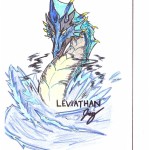When I think of the title Leviathan, my mind immediately wanders to the mythical creature that shares this name. In ancient folklore, the Leviathan is a serpent-like beast immense in size that dwells within the seas. Similar to a dragon, its thick and scaly armor protects it from being penetrated by harpoons and spears while smoke escapes its nostrils when breathing fire. Alongside these features, its strength is said to be so forceful that it is capable of creating tsunamis. Now, having taken this majestic beast into consideration, let us reflect on the image of the Leviathan presented to us in the introduction.
Behind the hills of this village stands a Leviathan in the form of a man, his head of his own, but his body composed of several other men. It is interesting to note that this version of the Leviathan is given only one head while the serpent alternative can be interpreted with various appearances such as a female counterpart or be multi-headed. Professor Hendrick’s lecture touched a little on this, where as a whole, the human Leviathan represents the sovereign and its head specifically represents the monarch. If the monarch is not singular, then it is unable to enforce and have complete control over the laws effectively. Hence, the sword (representing the military) and staff (representing religion) are held in this being’s hands, which unlike its body, are not made up of a multitude of men.
Upon closer inspection of the Leviathan’s body, you can see the men are positioned in such a way that they all face towards the head. Yes, this shows how the citizens collectively agree to be unified, but they only make up a portion of the body as a whole, the torso. Where is the lower body? Does it have one at all? If so, are the men who create it looking up at the head as well, or does their gaze wander elsewhere? Or perhaps they are not shown at all to signify that those who oppose the monarch will not be accepted by the sovereign and community united. One speculation of mine is that the lower body is not revealed to portray the sacrifice of liberty men must make to ensure peace will be created and maintained for the benefit of all in society. With set boundaries for the impediments of mankind, one then has a clear understanding of what actions of freedom are acceptable and will not negatively impact others.
Although, it is perhaps the positioning of the Leviathan that works effectively in answering these questions. The torso of the human Leviathan is visible over the hills and gives the illusion of the serpent Leviathan emerging out of the water, intimidating its attackers and prey. Because it is grand in size and power, perhaps these attributes are left represented by the torso to install the same intimidation among men so that they obey the laws. Fear is, after-all, an emotion that compels us to preserve ourselves so that we may not have to confront danger and turmoil, but instead be left in peace.

